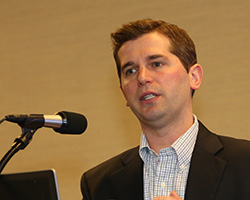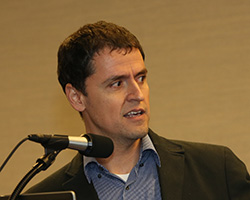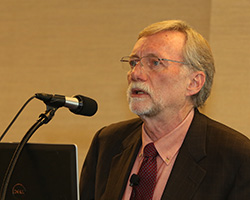Exploring the Psychological Science of Violence
Violence is one of the most widespread, if oftentimes inexplicable, forms of human behavior. From motive to method to outcome, violence spans all demographic boundaries and is the subject of widespread study by psychological scientists. Four eminent researchers at the 2014 APS Annual Convention examined factors that might shed light on the violence that humans encounter on a daily basis.

Adrian Raine
APS Fellow Adrian Raine of the University of Pennsylvania focused on prenatal circumstances that may influence violent behavior. He cited a Dutch study showing that children whose mothers have poor nutrition during pregnancy are 2.5 times more likely to develop antisocial personality disorder. Research by Ann Streissguth of the University of Washington School of Medicine also found that babies with fetal alcohol syndrome suffered neurological disabilities that made them more likely to become criminal offenders later in life. Specifically, Raine said, prenatal or developmental damage to the amygdala or prefrontal cortex was positively correlated with an individual’s odds of becoming violent. “The point is, there are factors early on in life, beyond the individual’s control, raising the odds, predisposing [some children] to later antisocial behavior,” Raine said. Raine framed a moral dilemma: Should society hold individuals who might be inclined toward violent behavior — through no fault of their own — fully responsible for their actions? And if not, is there a way to nip some of the adverse factors that affect such individuals in the bud before they act out? “If the amygdala is the emotional engine driving moral decision making and if that fire is burnt out inside … then how moral is it of us to punish psychopaths as harshly as we do, assuming psychopaths are not responsible for amygdala deformations that may be part of the reason they are amoral to begin with?” The implications of this line of reasoning should be carefully considered, Raine concluded, noting that Philipp Sterzer, Charité–Universitätsmedizin Berlin, cautioned in an American Journal of Psychiatry op-ed that while early intervention for at-risk individuals is crucial, we should guard against stigmatization based solely on the possibility of violent actions.

Matthew K. Nock
While Raine analyzed research on the roots of violence aimed at others, Matthew K. Nock of Harvard University turned the audience’s attention to the motivations behind self-harm. “Since the beginning of time, people have done things to try to harm themselves, and in extreme cases, to kill themselves,” Nock said, explaining that he hopes to gain a better understanding of the “suicidal mind” in order to predict self-harming thoughts and behavior as well as to develop effective interventions. Nock based much of his presentation on data from the World Mental Health Survey Initiative, which is conducted on behalf of the World Health Organization and includes samples from 28 countries. He and his collaborators found that, while there was variability in the reported rates of suicidal thinking across countries, the age of onset of those thoughts — adolescence — was remarkably consistent across the board, and individuals are most at risk during the first year after that onset. Furthermore, even if patients enter psychiatric hospitals, there is a “huge spike” in suicide the week after they are released. “We need a method for assessing risk that is not reliant on self-report,” Nock said. To that end, he suggested a tool developed by APS Past President Mahzarin R. Banaji — the Implicit Association Test — saying he hopes to use it to glean more reliable information about how suicidal patients feel and think.

David A. Pizarro
David A. Pizarro of Cornell University spoke to the audience about the violence of warfare, focusing on completely automated combat. Acknowledging the complicated ethical questions raised by the topic — “If [a robot] can’t suffer, how would [it] know what it’s like to suffer? What would restrain [it] from making me suffer?” — Pizarro suggested psychological science could inform moral decisions about automated warfare. “Many of the moral intuitions that we have simply aren’t well suited for keeping up with the rapid pace of technological advances,” he said. “There’s a mismatch between the source of our moral intuitions [human behavior] and the object of our moral intuitions [robots].” For example, while human soldiers must be trained to be logical and devoid of emotion, robots have both those qualities by default; while humans are fickle, robots are by their very nature constant. “Robots don’t get angry or emotional,” Pizarro said. “They will follow rules — we just need to figure out what the ‘right’ rules are.” To that end, the researcher argued that it’s necessary for humans to evaluate how to judge robotic actions so they can be programmed to act according to appropriate guidelines. “We have a say in what kinds of moral actions they take, what kinds of rules they follow,” Pizarro concluded. “We in many cases are holding those benefits [of automated warfare] back because we don’t have the right intuitions.”

John T. Monahan
APS Fellow John T. Monahan of the University of Virginia examined the psychological science at the junction of mental illness and violence. Monahan cited an epidemiological study by Jeffrey Swanson and colleagues that polled 10,000 adults on past violent behavior and assessed their mental health. The study found a surprisingly nuanced link between mental illness and violence. “Mental illness in the study was indeed a risk factor for violence, but it was only one among many risk factors,” including alcohol and especially drug abuse, said Monahan. Monahan’s own clinical research on the subject has been extensive. He and colleagues conducted the MacArthur Violence Risk Assessment Study, which attempted to isolate the mental illness component of the violence equation and find methods to combat it. Such methods include examining whether interventions aimed at reducing the symptoms of mental illness can in turn reduce the risk of violence. The researchers found that interventions — such as treatment sessions for violent patients who had been released from psychiatric hospitals — could indeed be effective, but only if patients attended them regularly. If individual patients attended only one session per month, their risk of committing a violent act was 10%, only modestly less than if they attended no sessions at all (14%); if they attended one session per week, however, their risk dropped to 3%, which made them actually safer than their nondisordered neighbors. But for the vast majority of individuals studied, medication may also have played an important role, Monahan cautioned. Because the MacArthur study focused primarily on risk assessment and not on the effects of intervention, he said, it was impossible to “tease out” which treatment — medication, psychotherapy, or both — was causing the reduction in violent behavior. The roots, causes, implications, and outcomes of violence can differ drastically, as the four speakers demonstrated. But psychological science and integrative research can certainly play a role in further illuminating — and helping prevent — some facets of this unique human behavior.





Comments
I have liked the research efforts, findings and inputs by these four scholars. Pizarro’s research is so on the cutting edge and very innovative.
Please, help provide me with more information about this pervasive phenomenon.
Dr. F. Molumeli
APS regularly opens certain online articles for discussion on our website. Effective February 2021, you must be a logged-in APS member to post comments. By posting a comment, you agree to our Community Guidelines and the display of your profile information, including your name and affiliation. Any opinions, findings, conclusions, or recommendations present in article comments are those of the writers and do not necessarily reflect the views of APS or the article’s author. For more information, please see our Community Guidelines.
Please login with your APS account to comment.